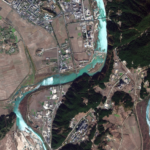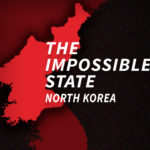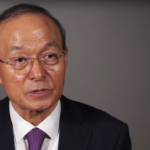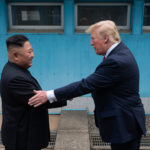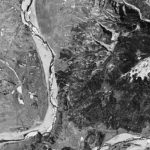November 19, 2019, by Joseph S. Bermudez Jr. and Marie DuMond—
Antiquated facilities, equipment, and processes, together with the continual plague of electricity shortages, will hinder any dramatic production increases of magnesite at North Korea's Taehung Youth Hero Mine... The Taehung Youth Hero Mine "has established the Juche orientation in the production of fireproof…
November 14, 2019, by Joseph S. Bermudez Jr., Victor Cha and Dana Kim—
Recent satellite imagery from November 2019 shows the presence of four specialized railcars that have been associated with the movement of radioactive material in the past. The last observed movement of these railcars by Beyond Parallel was in April 2019. It is unclear whether the railcars are being used for the outbound shipment of irradiated liquid or solid waste, disassembled but contaminated equipment or the movement of fissile material to facilities outside the Yongbyon area. A less likely alternative is the inbound shipment of radioactive material from a facility outside the Yongbyon area.
November 14, 2019—
This bonus episode comes from CSIS's Beyond Parallel Living History video series. We invite former South Korean Minister of Foreign Affairs and Trade Song Min-soon to discuss global efforts to denuclearize North Korea during the six-party talks. Minister Song was the director general for North American affairs and chief delegate during the six-party talks in 2005. He played a key role in the September 2005 multilateral denuclearization agreement with North Korea, involving the U.S., Japan, South Korea, China and Russia.
November 13, 2019—
This Living History interview features former South Korean minister of foreign affairs and trade, Song Min-soon. Song was director general for North American affairs and chief delegate during the six-party talks in 2005. He played a key role in the multilateral denuclearization agreement with North Korea, involving the United States, Japan, South Korea, China, and Russia, achieved in September 2005.
November 1, 2019, by Sue Mi Terry—
For Halloween, Kim Jong Un gave Donald Trump a trick, not a treat: North Korea fired two short-range missiles on Thursday toward the Sea of Japan. It was North Korea’s 13th weapons test this year—and the first since the Trump administration’s latest attempt to restart negotiations with North Korea quietly failed a few weeks ago. The first talks between the two sides in eight months broke down after only 8½ hours in Stockholm. The North Korean delegates stalked out, and Pyongyang subsequently said they wouldn’t resume the “sickening” negotiations with the U.S.
November 1, 2019—
In this episode, Andrew talks with resident North Korea expert Victor Cha, and Dr. Kang Choi, acting president of the Asan Institute for Policy Studies. They discuss North Korea’s recent missile launch, South Korea-Japan relations, and more... In this episode, Andrew talks with resident North Korea expert Victor Cha, and Dr. Kang…
October 22, 2019, by Joseph S. Bermudez Jr.—
Collected 14 months after the image provided in Part 5 (November 21, 1968) this March 17, 1970 KH-4B image of the Yongbyon Nuclear Research Center shows continued expansion within the village of Sang-dong, minor improvements in the operations, administration/laboratory and support areas, slowly continuing construction of the bridge across the Kuryong-gang and minor infrastructure improvements in the Pungang-ni area. Taken as a whole, these developments continue to indicate an ongoing first-phase construction project for the facility and very early infrastructure development efforts within a longer-term plan for future expansion.
October 21, 2019—
In this episode, Andrew talks with resident North Korea experts Victor Cha and Sue Mi Terry about the failed U.S.-North Korea Stockholm talks and what they mean for the stalled nuclear negotiations... In this episode, Andrew talks with resident North Korea experts Victor Cha and Sue Mi…
October 17, 2019, by Joseph S. Bermudez Jr. and Victor Cha—
Analysis of satellite imagery of the Punggye-ri Nuclear Test Facility acquired during 2019 and more specifically on September 23rd and October 9th, 2019 shows the facility in caretaker status, likely being maintained by security personnel. While there is no evidence of current efforts to restore any of the nuclear test portals, several observations lead us to believe the facility has not been permanently disabled and that the detonations in May 2018 are not necessarily irreversible.
October 9, 2019, by Joseph S. Bermudez Jr., Victor Cha and Dana Kim—
The October 2, 2019 Pukguksong-3 submarine-launched ballistic missile (SLBM) test launch has raised concerns over the forthcoming launch of North Korea’s first true ballistic missile submarine (SSB) as described in the Beyond Parallel Snapshot, which was published the same day.


